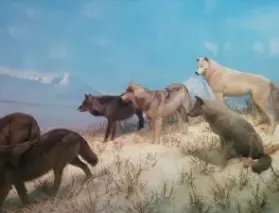 (Today’s article is by guest writer Brock Haussamen. For brief bio, see below.)
(Today’s article is by guest writer Brock Haussamen. For brief bio, see below.)
Of the thirty or so ants that arrived with my ant farm, five are still alive after about six weeks. I never had much interest in keeping ants, but E. O. Wilson and Bert Hölldobler’s Journey to the Ants sparked my curiosity. A plastic “ant farm” with its big window and the bag of gel “sand” arrived in the mail, followed a week later by a tube of reddish Harvester ants and a sliver of carrot, presumably for food and moisture. Instructions said these large ants can sting and warned to take care that they not get out. I lifted the opening at the top of the farm and poured the ants and carrot in. They took no time getting oriented and went to work trooping back and forth, carrying away a grain of sand at a time, starting to dig at the two ends of their sandy world, politely making room for each other when they crossed paths, pausing to rub antennae in their mysterious exchanges.
They ignored the bit of carrot. It gradually sank below the surface as the ants dropped bits of sand on it. It faded away to a grey-brown blur after a couple of weeks. The instructions said to put in a couple of drops of water and tiny bits of food—grain, fruit, vegetable—twice a week. Once, the ants rushed in excitement to a small ration of blackberry, but usually bits of green or brown ended up in one of the tunnels they had dug at the bottom of the sand.
The ants were all female worker ants, the directions said. There would be no queen and no ant offspring. The workers built tunnels continuously, sometimes bringing the sand to the surface and adding it to a growing pile on the left side as if they were trying to reach the top of the farm to escape. At the opposite side, they buried the dead. An ant would drag the body of a dead ant towards a kind of pit there. Over the weeks, body parts—heads, abdomen, legs, antennae—found their way below the surface and all through the sand. These days the view in the window is a cross-section of a whitish landslide, grey and blotchy with bodies and pieces, the carrot still a faint stain. The remaining ants weaken, though one still frisks briefly, the others barely moving, sometimes climbing clumsily over a body or prodding it. It has become a horror show.
And now there are the other ants in the house. Spring has arrived and as usual for the season the familiar, tiny, black ants appear, crawling over floors, counters, and woodwork in the bathroom and kitchen. They are the length of a long dash –– in print. I see them usually when they are going somewhere, sometimes singly, sometimes in a line, sometimes bolting with astonishing speed. My wife and I wipe them up. A few ant traps, from the arsenal of ant killers at the hardware store, provide enough poison to get rid of them. The tiny, running, black dashes have almost disappeared.
I thought of myself at first as having treated the Harvester ants well and the small blacks ants harshly. But now the differences seem trivial. Life depends on enclosures: single-celled creatures have cell walls, tubes enclose fluids in the bodies of plants and animals; trees have bark, animals have skins; houses and rooms are sheet-rocked, communities establish their borders. Ants make enclosures of their own: ant hills, tunnels, nests. In this house, the humans control the enclosures if they choose to. I invited the large pet ants in so I could watch them in the enclosure that I provided for them and so I could play caretaker, knowing that encasing them meant they would die there. And the scurrying invaders that have the run of the house do so only until the ant traps take effect. I haven’t treated one group “well” and the other “badly.” I’ve controlled them both more firmly than I thought, and doomed them both without meaning to.
Subscribe to The Spiritual Naturalist Society
Learn about Membership in the Spiritual Naturalist Society
__________
The Spiritual Naturalist Society works to spread awareness of spiritual naturalism as a way of life, develop its thought and practice, and help bring together like-minded practitioners in fellowship.
Bio: Brock Haussamen taught English at Raritan Valley Community College in New Jersey until retiring in 2006. He has followed and written for the Spiritual Natural Society for many years. His blog, 3.8 Billion Years: Lives and Life, explores the history of living things and the consolations that it offers. It remains available at 38by.blog.













